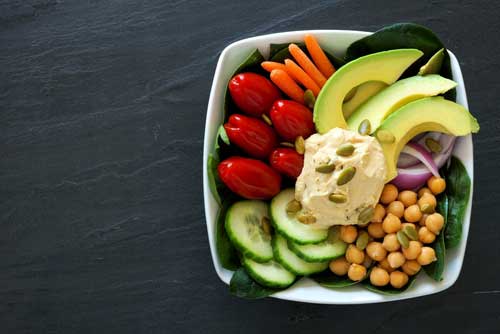
Move over plates, and let’s make room for a bowl – power bowls, that is. Meals in a bowl are one of the hottest food trends for 2016. We’re all looking for quick and simple ways to get a healthy meal on the table. Dinner in a bowl – what could be simpler? Not only does serving dinner or lunch in a bowl reduce the number of dishes you have to wash, if you choose the right sized bowl, it helps with portion control. Most of us could use a little help with portion sizes.
Introducing Power Bowls
What is a power bowl? They’re simply bowls filled with a balanced variety of clean, unprocessed foods. You might hear them referred to as Buddha bowls, nourishing bowls, protein bowls, or broth bowls, depending on what you add and how you create them.
To make a power bowl, you’ll need a moderate to large-sized bowl, a wooden, bamboo, or ceramic bowl will suffice. Line the bowl with a layer of greens or lettuce, fill it with your choice of veggies, whole grains or legumes, nuts, seeds, and a healthy protein source. There’s no “right” way to make a power bowl, as long as the foods you choose are whole, unprocessed ones and you include a balanced area of macronutrients – protein, carbohydrates, and healthy fat – in your bowl.
Let’s look at the components, in general, that go into a power bowl. You can customize each one to meet your individual tastes on a given day.
Power Bowls: Protein
Every bowl needs a source of protein, although it doesn’t have to be animal-based. Choose a lean meat, such as salmon or poultry, or keep it plant-based by adding tempeh, tofu, lentils, edamame, or beans to your bowl. A variation of a power bowl called a Buddha bowl is popular among vegetarians. Buddha bowls are typically made up of a plant protein, such as quinoa or lentils, and a variety of vegetables, sometimes seasoned with a cashew or tahini dressing, although you can add whatever sauce you want to create your custom, power-packed bowl.
Power Bowls: Fiber-Rich Carbs
A combination of protein AND fiber will fill you up and keep your energy level high, so the next component to add to a power bowl is your choice of cooked ancient grains, such as quinoa, amaranth, or millet, lentils, or your favorite beans. You have an abundance of beans to choose from – adzuki beans, black beans, cannellini beans, chickpeas, kidney beans, lima beans, mung beans, navy beans, or pinto beans. Roasted sweet potatoes are another source of slowly digested starch that’s loaded with phytonutrients.
Power Bowls: Vegetables
Be liberal with the veggies. Broccoli, cauliflower, Brussels sprouts, cabbage, greens, dark lettuce, watercress, microgreens, turnips, carrots, and radishes are only a few of the non-starchy vegetables you can add to a power bowl. To bring out their natural sweetness, roast the veggies before adding them to the bowl. Think about all of the vitamins, minerals, phytochemicals, and fiber you’re getting when you add lots of veggies. Plus, non-starchy vegetables are low in calories.
Power Bowls: Nuts, Seeds, and other Toppings
A sprinkling of nuts and seeds adds crunchiness along with extra protein, fiber, vitamins, and minerals to a power bowl and helps you stay fuller longer. You can also add a hint of sweet by sprinkling your power bowl with dried cranberries or even fresh berries like blueberries, raspberries, blackberries, or strawberries. Don’t forget nuts and seeds are a good source of heart-healthy, monounsaturated fats.
Another way to ramp up the monounsaturated fat content of a power bowl is to add a few slices of avocado to your bowl. The healthy fats in the avocado will help you better absorb the fat-soluble nutrients in the vegetables.
Power Bowls: Top It Off with a Dressing
A homemade dressing adds a burst flavor that makes a power bowl all the more delectable. Skip the bottled salad dressings you buy at the grocery store. Most are made with soybean oil and sweetened with added sugar. Make your own instead. You can whip up a simple, vinaigrette in almost no time. Here’s the formula for a basic vinaigrette you can enhance with your favorite spices:
. ¼ cup of Balsamic vinegar or other vinegar of your choice
. ½ cup extra-virgin olive oil
. A pinch of sea salt.
. Spices of your choice
Mix the ingredients together and refrigerate.
Another option is to use your favorite hummus or guacamole sauce in lieu of dressing or sauce in your power bowl. If spicy is more your thing, add a drizzle of Sriracha instead of dressing.
Now Enjoy Your Creation
Once you’ve added all the ingredients, admire the beauty of your power bowl and then enjoy its contents mindfully. With so many flavors and textures, each bite is unique, so spend time really tasting each one. When you eat mindfully you’ll be satisfied with less food. With so many variations, you can enjoy a different power bowl every day – and be healthier for it. Enjoy!
References:
Food Innovation Center. “Fresh Avocado Enhances Absorption of Essential Nutrients for Healthy Living”
Related Articles By Cathe:
Eat Like a Caveman: The Paleo Diet

